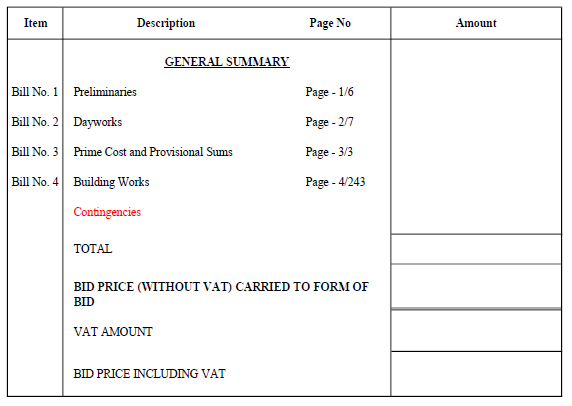What is a Contingency?
First of all, we need to understand the general meaning of contingency before explaining the other terms of construction contingency sum or contingency plan in construction Contracts.
A contingency is an uncertain / unforeseen event that might occur in the future, but is hard to accurately predict. A construction contingency sum is an amount of money set aside to cover any additional costs which could arise from a construction project.
Unforeseen building repairs, landscaping, or site works, and price fluctuations are some of examples for the contingencies. In simpler terms, it is a contingency fund for anything that cannot be predicted during the construction process.
Contingency Plan
Having a contingency plan can help mitigate the risks of a project. To begin, we need to do a risk assessment to determine the particular risks associated with the project. With the help of a contingency plan, we can address these risks and potentially avoid any major issues. This plan may also be relevant to certain parts of the project. By being proactive and having a contingency plan in place, we can reduce the chances of any negative outcomes.
Common project risks:
- Adverse weather: Unfavorable weather conditions that can delay or obstruct construction.
- Industrial Disputes: Labor disputes between management and workers that can delay the work.
- Supplier Failure: When suppliers are unable to deliver materials on time.
- Incomplete Drawings and Specifications: When drawings and specifications are unclear or incomplete.
- Unknown Site Conditions: Unexpected conditions on the job site that can cause delays or additional work.
- Natural Disasters: Acts of nature that can delay or disrupt construction.
- Availability of Building Materials: Lack of availability of required materials can cause delays.
- Labour Shortage: Unavailability of skilled labour can cause delays.
- Unexpected Increment of Material Cost: Unforeseen increases in the cost of materials can affect budget.
- Poor Project Management: Poor management and coordination of resources can lead to delays or disruptions.

Contingency Sum / Money
Contingency Sum is also a money provision in construction like provisional sum and prime cost sum.
No matter the scale or complexity of a construction project, there are usually items or issues that crop up due to unknown conditions, design conflicts, or changes. How these matters are handled financially is often based on the contract between the construction crew and the owner/architect. Generally, such issues are managed with a contingency money.
Contingency money is usually stated as a percentage. For brand new construction, a prudent amount of contingency cash to keep in the budget would be 5-10%. For renovations and addition projects , it could be as much as 20%.
Because of the vast number of risks, the contingency percentage is often kept to a maximum for the start of the project. As the project progresses and risks are diminished, the percentage can be reduced.

Types of Contingency sum
In a Construction Project, Two types of Contingency sum exist.
- Physical Contingencies.
- Financial Contingencies.
Physical Contingencies
Physical Contingencies are the safeguards against physical uncertainties, allowing the project to be completed without any delay. In most cases, these contingencies come in the form of variations.
Financial Contingencies
Fluctuations in the price of resources (Labour, Material & Machinery) can cause financial instability. Price Escalation or Price Fluctuation is used to calculate the impact of these changes on the bottom line. This can mean either a loss or a gain for the company.
Price escalation is a term used to describe the process of increasing the price of a product or service over time due to market conditions or other external factors. Price escalation is typically used to reflect the cost of inputs (labor,
materials, etc.) or to account for inflation over time. Price escalation can also be used to increase the price of a product or service in response to increased demand or a higher level of competition.
Dispelling Myths
Myth #1: “Contingency sums are unnecessary padding for the budget.”
Reality: Contingency sums are not mere luxuries; they are essential safeguards against the unknown. They serve as insurance policies for your project’s success, protecting against unexpected hurdles and enabling course corrections.
Myth #2: “Once allocated, contingency sums are free to spend on extras.”
Reality: Contingency sums should be utilized solely for mitigating risks and uncertainties. They are not a license for frivolous expenditures or scope creep. Prudent management and strict approval processes ensure their purpose remains intact.
Proactive Planning
Contingency sums are not passive placeholders. Instead, they are tools of proactive planning and strategic thinking. By actively identifying and addressing potential risks, project teams can minimize the impact of uncertainties, increase stakeholder confidence, and set the stage for success.
Just as an experienced mountain climber studies the terrain, checks the weather, and prepares for unforeseen circumstances, project managers should embrace the spirit of preparedness. This mindset empowers them to navigate the ever-changing landscape of project execution with resilience and adaptability.
Practical Tips for Contingency Sum Management
- Begin with a thorough risk assessment: Identify potential risks and uncertainties that may arise throughout the project lifecycle.
- Involve stakeholders and subject matter experts early on: Tap into the collective wisdom and experience of your team to inform the contingency sum estimation process.
- Continuously monitor and update the contingency sum: As the project progresses, reassess risks, adjust allocations, and ensure the contingency sum aligns with evolving circumstances.
- Maintain transparency and communication: Keep all relevant parties informed about the purpose, utilization, and status of the contingency sum to foster trust and collaboration.
- Document and learn from experiences: Capture lessons learned from past projects and incorporate them into future planning to enhance the accuracy and effectiveness of contingency sums.
- External Forces: Taming the Unpredictable
Contingency sums don’t exist in a vacuum. External factors such as economic fluctuations, regulatory changes, or natural disasters can impact project dynamics and necessitate adjustments to the contingency sum. Much like a seasoned sailor navigating stormy seas, project teams must stay vigilant, anticipate these external forces, and be ready to adapt their contingency plans accordingly.
Project requirements are known to evolve, almost like the changing tides. Contingency sums can come to the rescue when faced with unexpected scope changes or variations. Whether it’s accommodating new stakeholder requests, incorporating design revisions, or adapting to regulatory updates, the flexibility provided by a contingency sum allows projects to navigate these twists without derailing the budget or timeline.
Legal and Contractual Considerations
Contingency sums have legal and contractual implications that demand attention. Understanding the legal framework and contractual obligations related to contingency sums is vital for project managers and stakeholders. From ensuring proper documentation to adhering to procurement regulations, this knowledge helps establish a solid foundation for the effective utilization and governance of contingency sums.
Technology
In the digital age, technology is a formidable ally. Innovative tools, such as project management software, data analytics platforms, and AI-driven risk assessment models, can enhance the management of contingency sums. By leveraging these technological advancements, project teams can gain deeper insights, streamline processes, and optimize the allocation and utilization of contingency sums.
Frequently Asked Questions
How can be reduced contingency during the project stages?
- At the preliminary /Initial stage, total preliminary estimates/budget might include a 15% contingency.
- In the elemental cost plan, 10% of the cost estimate might be included.
- Once awarded the contract, this might be five percent (%) of the contract value as a contingency sum in the contract.
Why we need Contingency sum in the construction?
Contingency sums are used in construction projects to provide a buffer for unforeseen costs. They are used to cover any unexpected expenses that may arise during the project, such as changes to scope, materials, or labor. By including a contingency sum in the budget for a project, the contractor can ensure that unexpected costs will be covered without needing to go back to the client for additional funds.
Conclusion
In conclusion, a contingency is an unpredictable event that may take place in the future, and construction contingency sums and contingency plans are tools which help to prepare for any issues related to the construction project. They help to provide a secure and organized environment, ensuring that the project is completed on time and without any surprises.







2 thoughts on “Contingency Sum in Construction : Free Beginner’s Guide #3”